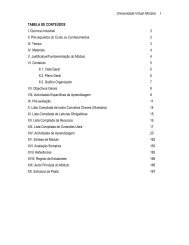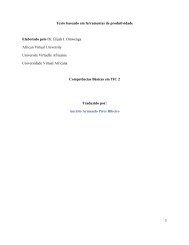Physical Chemistry 2.pdf - OER@AVU - African Virtual University
Physical Chemistry 2.pdf - OER@AVU - African Virtual University
Physical Chemistry 2.pdf - OER@AVU - African Virtual University
You also want an ePaper? Increase the reach of your titles
YUMPU automatically turns print PDFs into web optimized ePapers that Google loves.
Learning activity # 2<br />
Title of Learning Activity: Colloids<br />
On completion of this Unit, the learner should be able to:<br />
<strong>African</strong> <strong>Virtual</strong> <strong>University</strong><br />
• Describe the properties of colloidal systems<br />
• Differentiate the different types of colloidal systems<br />
• Explain factors affecting the stability of colloidal systems<br />
• Describe and explain the properties of colloids such diffusion, osmosis, viscosity<br />
and electrical properties of colloidal systems<br />
Summary of the learning activity<br />
This learning activity is about colloids and their properties. By definition these are<br />
solutions with particles in a particular size range and exhibit characteristic properties.<br />
The colloidal system is a homogeneous system comprising a disperse phase in<br />
the range 50 -2000 Å in a continuous phase. Colloids are found in many natural and<br />
synthetic products and have their own peculiar properties. These properties are related<br />
primarily to the particle size and surface. In this activity, the learner is introduced to<br />
colloidal systems, the types of colloids and how such colloidal systems are prepared.<br />
Since colloidal systems are in part defined based on size it is important that the size<br />
of the disperse phase be maintained within the colloidal range. Hence, factors that<br />
affect colloidal stability are also examined. The unique properties of colloids, such as<br />
electrical and surface properties are discussed. Colloids are particularly significant to<br />
the study of surface phenomenon because their surface area-to-volume ratio is very<br />
large. Consequently, their properties are dominated by events at their surface.<br />
List of REQUIRED readings<br />
• Colloids<br />
• Interfaces, Colloids And Gels<br />
List of relevant useful links<br />
Experiments On Surface Phenomena And Colloids<br />
http://www.funscience.com<br />
Colloids<br />
http://ull.chemistry.uakron.edu/genobc/Chapter_07/
















